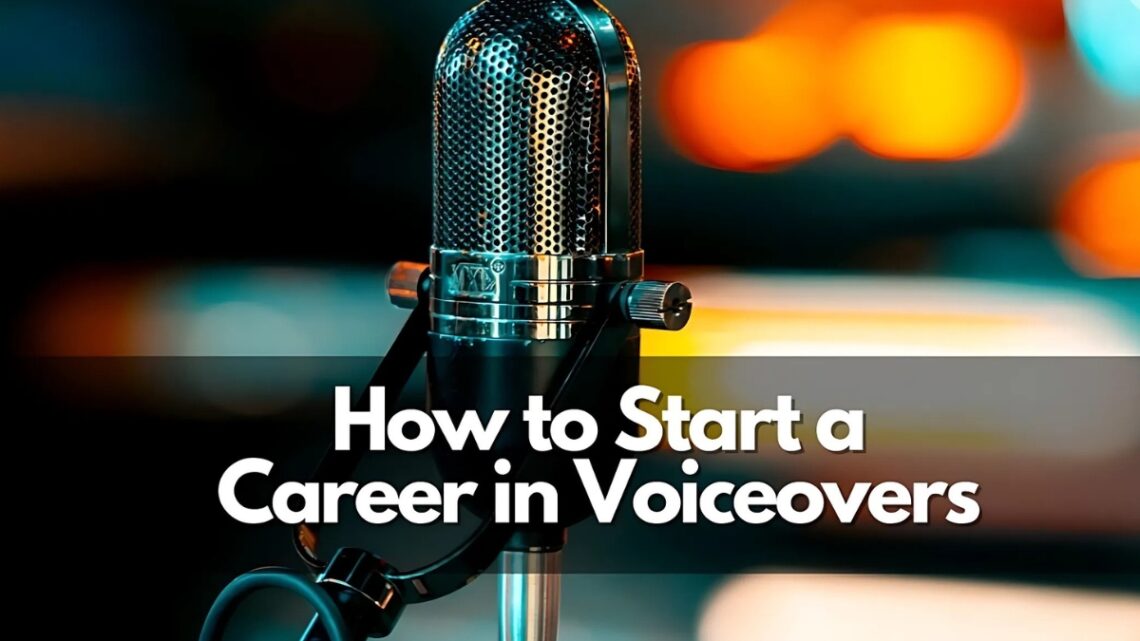
How to Do Voiceover Work: Complete Guide to Starting Your VO Career
Did you know that the global voice acting market is projected to reach $8.7 billion by 2027? Whether you’ve been told you have a great voice or dream of bringing characters to life, starting a voiceover career could be your next exciting venture! In this comprehensive guide, we’ll walk you through everything you need to know about breaking into the voiceover industry. From setting up your first home studio to landing paying clients, we’re here to help you transform your voice into a thriving business.
Essential Equipment for Voiceover Work
Let’s start with the most crucial piece of equipment: your microphone. After testing dozens of options over the years, I’ve learned that you don’t need to break the bank to get started, but you do need something decent. For beginners, I absolutely recommend the Audio-Technica AT2020 USB ($99) or the Blue Yeti ($130). These USB microphones will give you surprisingly good quality without requiring an audio interface.
But here’s the thing – if you’re serious about voiceover work, you’ll eventually want to upgrade to an XLR setup. The Rode NT1-A ($229) paired with a Focusrite Scarlett Solo interface ($120) is my go-to recommendation. The sound quality difference is night and day compared to USB mics, and clients can absolutely tell the difference.
Now, let’s talk about the elephant in the room: acoustic treatment. I learned this lesson the hard way after recording in an empty room that made me sound like I was in a cave! You don’t need fancy foam panels to start – I actually began with heavy moving blankets hung on the walls and a DIY reflection filter made from a cardboard box and acoustic foam. Total cost? About $50.
For software, you might be tempted to spend hundreds on Pro Tools, but honestly, Reaper ($60) or even the free Audacity will do just fine for beginning voice work. I used Audacity exclusively for my first year of voiceover work, and it handled everything from basic editing to noise reduction perfectly well.

Here’s my must-have equipment list with current prices:
- Pop filter ($15-20)
- Adjustable mic stand ($25-30)
- Closed-back headphones (Sony MDR-7506, $99)
- Basic audio interface (if using XLR mic)
- DAW software
- Some form of acoustic treatment
Pro tip: Don’t forget about your recording space! I converted a small closet into a recording booth using moving blankets and foam panels. The clothes actually help absorb sound reflections! If you can’t do that, create a “fort” around your mic using blankets draped over chairs. It might look silly, but it works surprisingly well.
One mistake I see beginners make is spending too much on a fancy microphone while ignoring room treatment. Trust me on this – a $100 mic in a well-treated room will sound better than a $1000 mic in an untreated space. I learned that one the expensive way!
Remember to start with the basics and upgrade as you book more work. That AT2020 USB mic with some basic acoustic treatment will get you started for under $200. As you book more gigs, reinvest that money into better gear. Your first priority should always be clean, professional sound – not fancy features you might never use.
And please, whatever you do, don’t record with your phone or laptop’s built-in mic. I actually had a potential client tell me they could tell I was using my iPhone for early auditions. Talk about embarrassing! Even a basic USB mic will be leagues better than that.
Building Your Voiceover Skills
When I first started practicing voice acting, I made the classic beginner’s mistake of trying to sound like a “voice artist.” You know that deep, announcer-guy voice? Yeah, don’t do that. What I’ve learned after years of coaching and practice is that authenticity is everything. Your natural voice, with proper training, is your most powerful tool.
Let’s talk about fundamental techniques. The foundation of all good voiceover work is breath control. Here’s a simple exercise I do daily: Place one hand on your diaphragm (just below your rib cage) and take a slow breath, counting to four. Your hand should move outward. Hold for four counts, then release for eight counts. Do this ten times each morning. It sounds simple, but it’s made a huge difference in my ability to handle long scripts without getting winded.
For microphone technique, here’s something I wish I’d known earlier: The “fist rule.” Make a fist and hold it between your mouth and the mic – that’s roughly the distance you should maintain for most voiceover work. Of course, this varies depending on the effect you want. Moving closer creates a more intimate sound (great for audiobooks), while backing away works better for more energetic commercial reads.
Script interpretation was my biggest challenge early on. I’d get a script and just… read it. Big mistake! Now I use what I call the “coffee shop method.” I imagine explaining the script’s message to a friend over coffee. How would you naturally emphasize certain words? Where would you pause? This simple mindset shift has transformed my delivery from robotic to conversational.

For character voice development, here’s my daily routine:
- 15 minutes of tongue twisters (focus on clarity, not speed)
- Reading newspaper headlines in 3 different emotions
- Recording and analyzing my own voice
- Mimicking 5 different characters from my favorite animated shows
- Practicing pitch variation exercises
The real game-changer for me was finding the right coach. While YouTube tutorials are great (and I still use them), nothing beats personalized feedback. I recommend starting with Edge Studio’s free voice evaluation – it helped me understand which voiceover genres suited my voice best. For ongoing training, Julie Eisen’s weekly workout groups and Such A Voice’s online courses are worth every penny.
Here’s a pro tip that transformed my practice sessions: Record everything! I mean everything. I record myself ordering coffee, leaving voicemails, even reading food labels. Then I listen back critically. It’s uncomfortable at first (who likes hearing their own voice?), but it’s the fastest way to improve.
Don’t forget about vocal health – it’s just as important as technique. I learned this the hard way after losing my voice before an important audition. Now I swear by warm lemon water, vocal rest periods, and daily vocal warm-ups. Staying hydrated isn’t just good advice – it’s essential for maintaining vocal stamina during long recording sessions.
Remember, building voiceover skills is a marathon, not a sprint. I spent six months just practicing before I did my first professional audition. Was it frustrating? Absolutely. But that foundation of solid technique has paid off countless times in my work. Start with the basics, be patient with yourself, and practice consistently. Your voice is an instrument, and like any instrument, it gets better with dedicated practice.
Creating Your Voiceover Demo Reel
Creating your voiceover demo reel can feel super overwhelming – I know because I redid mine seven times before getting it right! Let me share what I’ve learned about crafting a demo that actually books work, and help you avoid some of the expensive mistakes I made along the way.
First, let’s bust a common myth: you don’t need one demo reel that shows everything you can do. When I started, I crammed commercial, narration, character voices, and corporate reads all into one demo. Big mistake! Casting directors want to hear exactly what they’re looking for, not wade through other stuff to find it. Now I maintain separate demos: one for commercials, one for corporate/e-learning, and one for character work.
Here’s my tried-and-true process for creating a professional demo: Start by recording 40-50 short snippets in your target genre. Yes, that many! I learned this approach from my coach, and it works because it lets you cherry-pick your absolute best reads. Pick the top 6-8 pieces that showcase different aspects of your voice while maintaining consistency. For a commercial demo, aim for 60-90 seconds total. Corporate or narrative demos can stretch to 2 minutes, but honestly, shorter is usually better.
Speaking of time – here’s something I wish I’d known earlier: The first 10 seconds of your demo are absolutely crucial. Put your strongest, most representative piece first. I used to save my “best” clip for last, but most casting directors won’t listen that far if they’re not hooked immediately.
Let me share some embarrassing mistakes I’ve seen (and made!) with demo reels:
- Using copyrighted music (those licensing fees are no joke!)
- Including too many sound effects that distract from the voice
- Making segments too long (anything over 20 seconds per clip is too much)
- Using obviously fake brand names (pros can spot these a mile away)
- Recording everything with the same energy level

For content selection, here’s what’s working right now: For commercial demos, mix both hard-sell and conversational reads. Include at least one “real person” delivery – you know, that casual, talking-to-a-friend style that’s super popular now. For corporate demos, include technical terminology to show you can handle complex scripts. Just make sure you’re pronouncing everything correctly (I once mispronounced “MySQL” in my tech narrative demo… not my proudest moment).
Want to know my secret weapon for demo content? I collect interesting phrases from real commercials and corporate videos, then rewrite them slightly to avoid copyright issues. This gives my demos an authentic, professional feel while being completely original.
Here’s a crucial tip about recording quality: If you can’t achieve truly professional sound quality at home, invest in studio time. I learned this the hard way after spending countless hours trying to make my home recordings sound “good enough.” They weren’t, and that demo never got me work. Now I budget about $300-400 for professional studio time when creating a new demo – it’s worth every penny.
The trickiest part is showing versatility without losing focus. I solve this by ensuring each clip demonstrates a different skill while staying within the same general style. For example, my commercial demo includes a friendly retail spot, an authoritative automotive read, and a warm, caring healthcare spot – different emotions and approaches, but all clearly commercial work.
Remember, your demo isn’t just showing off your voice – it’s showing clients you understand their needs and industry standards. Take your time, get professional feedback, and don’t be afraid to update it as trends change. And please, don’t publish your first attempt! Consider your first few demos as practice runs. I still cringe thinking about the first demo I sent out, complete with cheesy sound effects and over-the-top delivery.
Finding Voiceover Work Opportunities
Let’s start with online platforms, because that’s where most beginners (including myself) find their first gigs. Voice123 and ACX were my starting grounds, but here’s the thing – don’t put all your eggs in one basket. I pay for a premium membership on Voice123 ($399/year) and maintain a free profile on ACX for audiobook work. Fiverr and Upwork can also be good starting points, though you’ll need to be strategic about pricing. I started at $50 per project and gradually increased my rates as I built a reputation.
Here’s a breakdown of what’s working for me on these platforms:
- Voice123: Best for commercial and corporate work
- ACX: Exclusively for audiobooks (royalty share options available)
- Bodalgo: Great for European market access
- VoiceBunny: Good for quick, short-form projects
- CastVoices: Newer platform but growing quickly
Now, about agents – this is where I made a rookie mistake. I submitted my demo to 20 agencies before my voice was really ready. Looking back, I should have waited until I had at least 50 solid auditions under my belt. When you are ready, research agencies thoroughly. I found my current agent through the Voice Over Resource Guide ($40/year subscription), and it was worth every penny.
Direct marketing has become my secret weapon. Here’s my monthly routine:
- Email 10 new production companies
- Connect with 5 new potential clients on LinkedIn
- Follow up with previous clients
- Share new demos with my network
- Post voice samples on social media
Speaking of networking – the voiceover community is incredibly supportive once you find your way in. I joined a weekly Zoom workout group ($25/month) where we practice scripts together and share job leads. Some of my best gigs have come through referrals from other voice actors. Remember, we’re colleagues, not competitors – there’s plenty of work to go around.

Let’s talk about auditions, because this is where I see so many talented voices stumble. My hit rate improved dramatically when I started following these guidelines:
- Read the entire specs before recording (I once did a whole audition in the wrong accent!)
- Submit within 4 hours if possible
- Keep slates short and professional
- Follow direction exactly (if they want three takes, send exactly three)
- Name files according to their specifications
One game-changing audition tip: I keep a spreadsheet tracking every audition, including the specs, my interpretation choices, and whether I got a callback. After 100 auditions, patterns emerged that helped me understand what was working and what wasn’t.
Here’s something nobody told me: Local work can be goldmine. I reached out to every video production company within 50 miles and landed three regular clients. They prefer working with local talent, and the competition is much lower than on national platforms.
Remember to treat your marketing efforts like a regular job. I dedicate two hours every morning to auditions and marketing before doing any paid work. It felt like overkill at first, but it’s what transformed voice acting from a hobby into a real career for me.
And please, don’t get discouraged by rejection. I auditioned 247 times before booking my first national commercial. Keep track of your progress, celebrate small wins, and remember that every ‘no’ gets you closer to a ‘yes’. The key is to keep showing up, keep improving, and keep putting yourself out there.
Elevate your online presence with the SEO and Social Media Marketing EBook Sets! These expertly curated guides cover essential strategies for driving organic traffic, boosting engagement, and maximizing conversions. Learn how to master SEO techniques, craft effective social media campaigns, and grow your brand across platforms. Perfect for marketers, entrepreneurs, and businesses aiming for digital success. Unlock the power of SEO and social media with these must-have eBooks today!
Business Aspects of Voiceover Work
First, let’s tackle the elephant in the room: pricing. Here’s what I’ve found works in today’s market (as of 2024):
- Commercial spots: $250-500 for local, $500-2000+ for regional/national
- E-learning: $250-400 per finished hour
- Corporate narration: $200-350 per finished hour
- Explainer videos: $250-500 per video under 2 minutes
- Audiobooks: $250-400 per finished hour or royalty share (ACX)
But here’s the thing about rates – they’re not just about the recording time. I learned to factor in editing time, revisions, and usage rights. One of my biggest early mistakes was not clearly defining usage terms. Now I use a tiered pricing structure: one rate for internal corporate use, another for web, and higher rates for broadcast.
When it comes to your website, keep it simple but professional. I wasted $2000 on a fancy site with animations before realizing clients just want three things:
- Easy access to your demos
- Clear information about your services
- A simple way to contact you
I use Wix ($14/month) for my site now, with separate pages for different voice styles and a clear contact form. Make sure your demos load quickly – I lost a potential client because my audio files took too long to play!
Contract management was scary at first, but I’ve developed a system that works. I use Hello Sign ($15/month) for contracts and keep templates for:
- Session rates agreement
- Usage rights contract
- Non-disclosure agreement
- Revision policy
- Payment terms
Speaking of money management – QuickBooks Self-Employed ($15/month) has been a lifesaver for tracking income and expenses. Keep every receipt! You’d be surprised what’s deductible:
- Home studio equipment
- Website costs
- Training and coaching
- Marketing materials
- Professional memberships
- Part of your home internet and phone bills

Building your personal brand takes time, but consistency is key. I learned to focus on one or two niches rather than trying to be everything to everyone. My breakthrough came when I specialized in medical narration and tech explainer videos – suddenly I was the “go-to voice” for those specific types of work.
Here’s my daily business management routine:
- 30 minutes on invoicing and bookkeeping
- 1 hour on marketing and social media
- 15 minutes updating my CRM (I use HubSpot’s free version)
- Weekly backup of all project files
- Monthly review of rates and client feedback
One mistake I made early on was not setting boundaries with clients. Now I have clear policies for:
- Rush fees (50% additional for same-day turnaround)
- Revision limits (2 rounds included, additional rounds at hourly rate)
- Payment terms (50% upfront for new clients)
- Project minimums ($150 minimum booking)
Remember to save for taxes! I set aside 30% of every payment in a separate account. After losing half my first year’s profits to unexpected tax bills, I now make quarterly estimated tax payments to avoid any surprises.
Building your personal brand isn’t just about social media presence – it’s about consistency in every client interaction. I use Bonjoro ($20/month) to send personalized video messages to new clients. It takes an extra few minutes but has dramatically improved my client retention rate.
Don’t forget about insurance! After my laptop crashed in the middle of a big project, I learned the hard way about the importance of business insurance and backup systems. Now I have both equipment insurance and professional liability coverage – it’s about $500 annually but worth every penny for peace of mind.
Advanced Voiceover Career Development
The turning point in my career came when I stopped trying to book every type of voiceover work and focused on e-learning and medical narration. I had originally avoided these niches because they seemed “boring” compared to commercial work. What a wake-up call when I realized these “boring” niches were bringing in steady, well-paying work while my commercial colleagues were struggling between gigs!
Here’s my approach to specialization: Pick two niches that overlap somehow. For me, it was medical narration and e-learning – lots of medical training content needs both! Think about your background too. I used my experience explaining complex topics to craft a unique selling proposition: “Making complicated content clear and engaging.”
For continuous improvement, I’ve developed what I call my “power hour” routine:
- 20 minutes studying voice actors I admire
- 20 minutes practicing new techniques
- 20 minutes analyzing feedback from recent sessions
Pro tip: Record yourself reading the same script every six months. I keep these recordings in a folder called “Progress Track.” The improvement over time is incredibly motivating, and it helps identify areas that still need work.
Networking in voiceover is unique because we rarely meet in person. I’ve found success with these strategies:
- Participating in weekly virtual script reading groups
- Attending online industry conferences (VO Atlanta Virtual was a game-changer)
- Being active in specialized Facebook groups
- Contributing to voiceover podcasts
- Offering to mentor newcomers (teaching others actually improved my own skills!)

Let’s talk about handling challenging clients – because they will come! I once had a client request 47 revisions on a 30-second spot. No joke! Now I have a system:
- Clear communication about expectations upfront
- Detailed written agreements about revisions
- Regular check-ins during long projects
- Professional but firm boundaries
- A “difficult client” surcharge built into my rates
Scaling your business is where things get really interesting. I hit a wall at about 30 hours of finished audio per month – there are only so many hours you can record! Here’s how I broke through:
- Hired a virtual assistant to handle admin ($300/month)
- Invested in better equipment to reduce editing time
- Created packages for repeat clients
- Built relationships with other voice actors for overflow work
- Developed passive income streams (like selling my voice acting course)
The biggest lesson I’ve learned about scaling? It’s not about working more hours – it’s about working smarter. I now make twice what I did two years ago while actually recording fewer hours. The key was raising my rates with existing clients gradually while only taking on new clients at my premium rates.
One strategy that really helped me level up was keeping a “win book” – a document where I record every successful project, positive client feedback, and breakthrough moment. When imposter syndrome hits (and it will!), this reminder of past successes helps me push through.
Remember, advanced career development isn’t just about booking more work – it’s about building a sustainable business that you enjoy running. I turned down a lucrative gaming project recently because I knew the screaming would strain my voice and impact my core medical narration work. These are the kinds of strategic decisions that separate sustainable careers from short-term success.
And here’s something nobody tells you: success in voiceover isn’t linear. I had months where I made five figures, followed by months where I barely covered my equipment payments. The key is to keep pushing forward, keep learning, and most importantly, keep treating it like a business, not a hobby.
Starting a voiceover career takes dedication, the right equipment, and continuous skill development – but the rewards can be incredible! Whether you’re looking to do voiceover work full-time or as a side hustle, the industry offers endless opportunities for growth. Take the first step today by setting up your basic recording space and practicing your craft. Remember, every successful voice actor started exactly where you are now. Ready to begin your voiceover journey? Use this guide as your roadmap to success!





